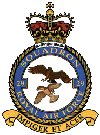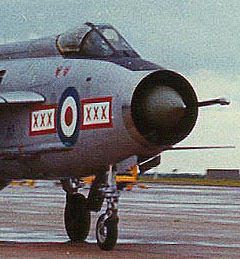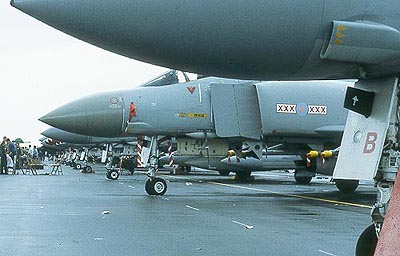Home | Airshows | The Hangar | Nostalgia | Links
Wattisham Squadrons
29 Squadron: 'X, X, one X' by Gary Parsons

 It all began on 7 November
1915 at Fort Grange, Gosport where the squadron formed as a Royal Flying
Corps unit from an element of 23 Squadron, initially with a rag-bag of
aircraft but soon taking on DH2s. The Western Front beckoned and March
1916 saw the squadron over the trenches of the Somme, to start some of
the epic air battles of the Great War. One of the aces of that conflict,
Flight Sergeant James McCudden VC served with Two-Nine, on his way to
notching up 57 kills. 1918 brought the formation of the Royal Air Force
and 29 Squadron, now with the SE5a, served near Dunkirk until the end
of the war. The following year saw the first disbandment of the squadron
in the rapid cutbacks of the post-war era, but it was re-born on 1 April
1923 at Duxford equipped with Sopwith Snipes. It was about this time that
the famous 'brewers cross' symbol was applied to the aircraft, although
rumour has it that it was incorrectly painted as the instruction was to
"paint x, x, one x" as in XXIX, the roman numeral for 29. Whether this
is true has never really been established, but it makes a good tale nonetheless!
Gloster Grebes followed in 1925, subsequently replaced by Siskins and
Bulldogs in the early thirties. The Abyssinian crisis of 1935 meant Two-Nine
was deployed to Egypt, Hawker Demons being operated at the time, supported
by Fairey Gordons which were used for night patrols. This experience formed
the basis of the squadron's future role for the next couple of decades.
It all began on 7 November
1915 at Fort Grange, Gosport where the squadron formed as a Royal Flying
Corps unit from an element of 23 Squadron, initially with a rag-bag of
aircraft but soon taking on DH2s. The Western Front beckoned and March
1916 saw the squadron over the trenches of the Somme, to start some of
the epic air battles of the Great War. One of the aces of that conflict,
Flight Sergeant James McCudden VC served with Two-Nine, on his way to
notching up 57 kills. 1918 brought the formation of the Royal Air Force
and 29 Squadron, now with the SE5a, served near Dunkirk until the end
of the war. The following year saw the first disbandment of the squadron
in the rapid cutbacks of the post-war era, but it was re-born on 1 April
1923 at Duxford equipped with Sopwith Snipes. It was about this time that
the famous 'brewers cross' symbol was applied to the aircraft, although
rumour has it that it was incorrectly painted as the instruction was to
"paint x, x, one x" as in XXIX, the roman numeral for 29. Whether this
is true has never really been established, but it makes a good tale nonetheless!
Gloster Grebes followed in 1925, subsequently replaced by Siskins and
Bulldogs in the early thirties. The Abyssinian crisis of 1935 meant Two-Nine
was deployed to Egypt, Hawker Demons being operated at the time, supported
by Fairey Gordons which were used for night patrols. This experience formed
the basis of the squadron's future role for the next couple of decades.
At the outbreak of the Second World War the squadron was the first to operate the Blenheim in the night-fighter role, flying from Debden, using the all-new aircraft intercept (AI) radar set. Beaufighters replaced the ageing Blenheim in September 1940, plus a certain young Flight Lieutenant Guy Gibson commenced his operational career, learning the skills that would prove invaluable some two and a half years later. Mosquitoes replaced the Beau' in 1943, still in the night-fighter role, continuing through to the end of the war at West Malling to form part of the post-war fighter defences.
 In 1950 29(F) Squadron became the first night-fighter
jet squadron with the introduction of the Meteor NF11, another 'first'
but not the last. Javelins followed the 'Meatbox' and a place within the
Near East Air Force in Cyprus, deploying to Zambia in the Rhodesian crisis.
1967 brought the lovely Lightning F3, a move to the tranquil Suffolk countryside
of Wattisham where they stayed until 1974 and re-equipment with the Phantom
FGR2 at the current home of Coningsby. Another 'first' was the firing
of the Skyflash missile in service, which enabled the squadron to deploy
Ascension Island, then later to RAF Stanley in 1982 as provision of air
defence to the staging routes for the Falklands conflict. At this time,
the squadron was under the control of Ian MacFadyen, who led the disbandment
address in October 1998.
In 1950 29(F) Squadron became the first night-fighter
jet squadron with the introduction of the Meteor NF11, another 'first'
but not the last. Javelins followed the 'Meatbox' and a place within the
Near East Air Force in Cyprus, deploying to Zambia in the Rhodesian crisis.
1967 brought the lovely Lightning F3, a move to the tranquil Suffolk countryside
of Wattisham where they stayed until 1974 and re-equipment with the Phantom
FGR2 at the current home of Coningsby. Another 'first' was the firing
of the Skyflash missile in service, which enabled the squadron to deploy
Ascension Island, then later to RAF Stanley in 1982 as provision of air
defence to the staging routes for the Falklands conflict. At this time,
the squadron was under the control of Ian MacFadyen, who led the disbandment
address in October 1998.
Back at Coningsby, the face of the station changed dramatically in 1984 with the construction of Hardened Aircraft Shelters (HAS), 29(F) Squadron being the first fighter squadron to operate from such a facility in the UK. Three years later the Tornado F3 was introduced into service, 29(F) Squadron being the first to operate the type (the F2 had only served with the OCU before this). A year later a unique operation known as 'Golden Eagle' was undertaken, which involved four F3s from Two-Nine flying around the world via Malaysia, Thailand, Singapore, Australia and America. The principal reason was to deploy fighters to Malaysia in support of the Malaysian Peninsular five nation defence arrangement, and is believed to be the first and only time a fighter squadron has flown around the world. The Tornados left Coningsby on 21 August 1988, returning some 11 weeks and 26,000 miles later.
 Operational duty followed in 1990 and 1991 over the skies of Kuwait
and Saudi Arabia, although the squadron did not get into the thick of
the action. November 1992 saw the squadron become the first F3 unit to
participate in Exercise 'Red Flag' at Nellis, in the Nevada desert close
to Las Vegas. This type of deployment has become a regular feature of
Tornado operations today, 29(F) Squadron's results from that first foray
giving the RAF a good reputation with the other participants; on one mission
19 kills were claimed for no losses. Since then, regular trips to Bosnia
were a feature of fighter life in the late '90s, until the Strategic Defence
Review of 1998 announced the end for 29, at least for the foreseeable
future. Official disbandment was to be affected by 1 April 1999, but as
the Station Commander Group Captain Al Lockwood explained, it was "left
to Strike Command and Group HQ to decide when the best time was. In reality,
we have suffered from pilot shortages - not only that, we wanted to let
it come to an end as a squadron, rather than let it dribble away slowly
as people are posted to other units; we wanted it to go out with a bang,
not a fizzle." So, on 31 October, the squadron's standard was laid up
at Cranwell, but optimism is high that it will not remain dormant for
long, for as Group Captain Lockwood said, "The squadron is not closing,
just resting".
Operational duty followed in 1990 and 1991 over the skies of Kuwait
and Saudi Arabia, although the squadron did not get into the thick of
the action. November 1992 saw the squadron become the first F3 unit to
participate in Exercise 'Red Flag' at Nellis, in the Nevada desert close
to Las Vegas. This type of deployment has become a regular feature of
Tornado operations today, 29(F) Squadron's results from that first foray
giving the RAF a good reputation with the other participants; on one mission
19 kills were claimed for no losses. Since then, regular trips to Bosnia
were a feature of fighter life in the late '90s, until the Strategic Defence
Review of 1998 announced the end for 29, at least for the foreseeable
future. Official disbandment was to be affected by 1 April 1999, but as
the Station Commander Group Captain Al Lockwood explained, it was "left
to Strike Command and Group HQ to decide when the best time was. In reality,
we have suffered from pilot shortages - not only that, we wanted to let
it come to an end as a squadron, rather than let it dribble away slowly
as people are posted to other units; we wanted it to go out with a bang,
not a fizzle." So, on 31 October, the squadron's standard was laid up
at Cranwell, but optimism is high that it will not remain dormant for
long, for as Group Captain Lockwood said, "The squadron is not closing,
just resting".
The impending deliveries of Eurofighters to Coningsby to form the initial OCU will see 29 Squadron re-born, sometime in late 2004 - as the disbandment ceremony leaflet proclaimed on the back cover in '99, 'Not so much goodbye….rather until we meet again!'
Home | Airshows | The Hangar | Nostalgia | Links